Meteorological Aspects of the Eastern North American Pattern with Impacts on Long Island Sound Salinity
Abstract
:1. Introduction
2. Materials and Methods
2.1. Salinity
2.2. Meteorological and Oceanic Data
2.3. Climate Indices
3. Methods
4. Results
4.1. ENA Index Relationships with Atmospheric Fields
4.1.1. MSLP Patterns
4.1.2. Streamfunction Patterns
4.1.3. Precipitation
4.1.4. ENSO Influences on the ENA Pattern
4.1.5. Tropical Convection
4.2. ENA Influences on Salinity
4.2.1. Anomalous Salinity Time Series
4.2.2. ENA Index and Salinity
4.2.3. Lag Correlation Analysis
4.2.4. Persistence of Salinity Anomalies
4.2.5. Salinity and ENSO
5. Conclusions and Discussion
Acknowledgments
Author Contributions
Conflicts of Interest
References
- Wallace, J.M.; Gutzler, D.S. Teleconnections in the geopotential height field during the Northern Hemisphere winter. Mon. Weather Rev. 1981, 109, 784–812. [Google Scholar] [CrossRef]
- Barnston, A.G.; Livezey, R.E. Classification, seasonality and persistence of low-frequency atmospheric circulation patterns. Mon. Weather Rev. 1987, 115, 1083–1126. [Google Scholar] [CrossRef]
- Thompson, D.W.; Wallace, J.M. The Arctic Oscillation signature in the wintertime geopotential height and temperature fields. Geophys. Res. Lett. 1998, 25, 1297–1300. [Google Scholar] [CrossRef]
- Hurrell, J.W. Decadal trends in the North Atlantic Oscillation: Regional temperatures and precipitation. Science 1995, 269, 676–679. [Google Scholar] [CrossRef] [PubMed]
- Barlow, M.; Nigam, S.; Berbery, E.H. ENSO, pacific decadal variability, and U.S. summertime precipitation, drought, and streamflow. J. Clim. 2000, 14, 2105–2128. [Google Scholar] [CrossRef]
- Hirsch, M.E.; DeGaetano, A.T.; Colucci, S.J. An east coast winter storm climatology. J. Clim. 2001, 14, 882–899. [Google Scholar] [CrossRef]
- Eichler, T.; Higgins, W. Climatology and ENSO-related variability of North American extratropical cyclone activity. J. Clim. 2006, 19, 2076–2093. [Google Scholar] [CrossRef]
- Seager, R.; Kushnir, Y.; Nakamura, J.; Ting, M.; Naik, N. Northern Hemisphere winter snow anomalies: ENSO, NAO and the winter of 2009/10. Geophys. Res. Lett. 2010, 37, L14703. [Google Scholar] [CrossRef]
- Rogers, J.C. Patterns of low-frequency monthly sea level pressure variability (1899–1986) and associated wave cyclone frequencies. J. Clim. 1990, 3, 1364–1379. [Google Scholar] [CrossRef]
- Leathers, D.J.; Yarnal, B.; Palecki, M.A. The Pacific/North American teleconnection pattern and United States climate. Part I: Regional temperature and precipitation associations. J. Clim. 1991, 4, 517–528. [Google Scholar] [CrossRef]
- Notaro, M.; Wang, W.-C.; Gong, W. Model and observational analysis of the northeast U.S. regional climate and its relationship to the PNA and NAO patterns during early winter. Mon. Weather Rev. 2006, 134, 3479–3505. [Google Scholar] [CrossRef]
- Ning, L.; Bradley, R.S. Winter precipitation variability and corresponding teleconnections over the northeastern United States. J. Geophys. Res. Atmos. 2014, 119, 7931–7945. [Google Scholar] [CrossRef]
- Schulte, J.A.; Najjar, R.G.; Li, M. Impacts of Climate Modes on Streamflow in the Mid-Atlantic Region of the United States. J. Hydrol. Reg. Stud. 2016, 5, 80–99. [Google Scholar] [CrossRef]
- Joyce, T.M. One hundred plus years of wintertime climate variability in the eastern United States. J. Clim. 2002, 15, 1076–1086. [Google Scholar] [CrossRef]
- Gong, G.; Wang, L.; Lall, U. Climatic precursors of autumn streamflow in the northeast United States. Int. J. Climatol. 2011, 31, 1773–1784. [Google Scholar] [CrossRef]
- Hull, C.H.J.; Titus, J.G. Greenhouse Effect, Sea-Level Rise, and Salinity in the Delaware Estuary; EPA 230-05-86-010; US Environmental Protection Agency and the Delaware River Basin Commission: Washington, DC, USA, 1986. [Google Scholar]
- Marengo, J.A.; Cavalcanti, I.F.A.; Satyamurty, P.; Trosnikov, I.; Nobre, C.A.; Bonatti, J.P.; Camargo, H.; Sampaio, G.; Sanches, M.B.; Manzi, A.O.; et al. Assessment of regional seasonal rainfall predictability using the CPTEC/COLA atmospheric GCM. Clim. Dyn. 2003, 21, 459–475. [Google Scholar] [CrossRef]
- Quan, X.; Hoerling, M.; Whitaker, J.; Bates, G.; Xu, T. Diagnosing sources of U.S. seasonal forecast skill. J. Clim. 2006, 19, 3279–3293. [Google Scholar] [CrossRef]
- Howarth, R.W.; Swaney, D.; Butler, T.J.; Marino, R. Climatic Control on Eutrophication of the Hudson River Estuary. Ecosystems 2000, 3, 210–215. [Google Scholar] [CrossRef]
- Galtsoff, P.S. The American oyster, Crassostrea virginica Gmelin. Fish. Bull. 1964, 64, 421–425. [Google Scholar]
- Munroe, D.; Tabatabai, A.; Burt, I.; Bushek, D.; Powell, E.N.; Wilkin, J. Oyster mortality in Delaware Bay: Impacts and recovery from Hurricane Irene and Tropical Storm Lee. Estuar. Coast. Shelf Sci. 2013, 135, 209–219. [Google Scholar] [CrossRef]
- Louis, V.; Russek-Cohen, E.; Choopun, N.; Rivera, I.; Gangle, B.; Jiang, S.; Rubin, A.; Patz, J.; Huq, A.; Colwell, R. Predictability of Vibrio cholerae in Chesapeake Bay. Appl. Environ. Microbiol. 2003, 69, 2773–2785. [Google Scholar] [CrossRef] [PubMed]
- Officer, C.B.; Biggs, R.B.; Taft, J.L.; Cronin, L.E.; Tyler, M.A.; Boyton, W.R. Chesapeake Bay Anoxia: Origin, development, and significance. Science 1984, 223, 22–27. [Google Scholar] [CrossRef] [PubMed]
- Wilson, R.E.; Swanson, R.L.; Crowley, H.A. Perspectives on long-term variations in hypoxic conditions in western Long Island Sound. J. Geophys. Res. 2008, 113, C12011. [Google Scholar] [CrossRef]
- Seitz, R.D.; Dauer, D.M.; Llansó, R.J.; Christopher, W.L. Broad-scale effects of hypoxia on benthic community structure in Chesapeake Bay, USA. J. Exp. Mar. Biol. Ecol. 2009, 381, S4–S12. [Google Scholar] [CrossRef]
- Sharp, J.H. Estuarine oxygen dynamics: What can we learn about hypoxia from long-time records in the Delaware Estuary? Limnol. Oceanogr. 2010, 55, 536–548. [Google Scholar] [CrossRef]
- Howell, P.; Simpson, D. Abundance of marine resources in relation to dissolved oxygen in Long Island Sound. Estuaries 1994, 17, 394–402. [Google Scholar] [CrossRef]
- Schulte, J.A.; Najjar, R.G.; Lee, S. Salinity and Streamflow Variability in the Mid-Atlantic Region of the United States and its Relationship with Large-scale Atmospheric Circulation Patterns. J. Hydrol. 2017, 550, 65–79. [Google Scholar] [CrossRef]
- Georgas, N.; Yin, L.; Jiang, Y.; Wang, Y.; Howell, P.; Saba, V.; Schulte, J.; Orton, P.; Wen, B. An Open-Access, Multi-Decadal, Three-Dimensional, Hydrodynamic Hindcast Dataset for the Long Island Sound and New York/New Jersey Harbor Estuaries. J. Mar. Sci. Eng. 2006, 4, 48. [Google Scholar] [CrossRef]
- Kalnay, E.; Kanamitsu, M.; Kistler, R.; Collins, W.; Deaven, D.; Gandin, L.; Zhu, Y. The NCEP/NCAR 40-Year Reanalysis Project. Bull. Am. Meteorol. Soc. 1996, 77, 437–471. [Google Scholar] [CrossRef]
- Dee, D.P.; Uppala, S.M.; Simmons, A.J.; Berrisford, P.; Poli, P.; Kobayashi, S.; Bechtold, P. The ERA-Interim reanalysis: Configuration and performance of the data assimilation system. Q. J. R. Meteorol. Soc. 2011, 137, 553–597. [Google Scholar] [CrossRef]
- Guttman, N.B.; Quayle, R.G. A historical perspective of US climate divisions. Bull. Am. Meteorol. Soc. 1996, 77, 293–303. [Google Scholar] [CrossRef]
- Earth System Research Laboratory: Physical Science Division. Climate Indices: Monthly Atmospheric and Ocean Time Series. Atmospheric and Oceanic Time series; Available online: https://www.esrl.noaa.gov/psd/data/climateindices/list/ (accessed on 2 December 2016).
- Trenberth, K.E.; Stepaniak, D.P. Indices of ENSO Revolution. J. Clim. 2001, 14, 1697–1701. [Google Scholar] [CrossRef]
- Whittaker, L.; Horn, L. Geographical and seasonal distribution of North American cyclogenesis, 1958–1977. Mon. Weather Rev. 1981, 109, 2312–2322. [Google Scholar] [CrossRef]
- Reitan, C. Frequencies of cyclones and cyclogenesis for North America, 1951–1970. Mon. Weather Rev. 1974, 102, 861–868. [Google Scholar] [CrossRef]
- Kocin, P.J.; Schumacher, P.N.; Morales, R.F., Jr.; Uccellini, L.W. Overview of the 12–14 March 1993 superstorm. Bull. Am. Meteorol. Soc. 1995, 76, 165–182. [Google Scholar] [CrossRef]
- Miller, W.D.; Kimmel, D.G.; Harding, L.W., Jr. Predicting spring discharge of the Susquehanna River from a winter synoptic climatology for the eastern United States. Water Resour. Res. 2006, 42, W05414. [Google Scholar] [CrossRef]
- Hanna, E.; Cropper, T.E.; Hall, R.J.; Cappelen, J. Greenland Blocking Index 1851–2015: A regional climate change signal. Int. J. Climatol. 2016, 36, 4847–4861. [Google Scholar] [CrossRef]
- Ning, L.; Mann, M.E.; Crane, R.; Wagener, T. Probabilistic projections of climate change for the mid-Atlantic region of the United States—Validation of precipitation downscaling during the historical era. J. Clim. 2012, 25, 509–526. [Google Scholar] [CrossRef]
- Lee, S.-K.; Mapes, B.E.; Wang, C.; Enfield, D.B.; Weaver, S.J. Springtime ENSO phase evolution and its relation to rainfall in thecontinental U.S. Geophys. Res. Lett. 2014, 41, 1673–1680. [Google Scholar] [CrossRef]
- Lee, S.-K.; Wittenberg, A.T.; Enfield, D.B.; Weaver, S.J.; Wang, C.; Atlas, R. US regional tornado outbreaks and their links to spring ENSO phases and North Atlantic SST variability. Environ. Res. Lett. 2016, 11, 044008. [Google Scholar] [CrossRef]
- Ashok, K.; Behera, S.K.; Rao, S.A.; Weng, H.; Yamagata, T. El Niño Modoki and its possible teleconnection. J. Geophys. Res. 2007, 112, C11007. [Google Scholar] [CrossRef]
- Ashok, H.; Yamagata, T. Climate change: The El Niño with a difference. Nature 2009, 461, 481–484. [Google Scholar] [CrossRef] [PubMed]
- Kug, J.-S.; Jin, F.-F.; An, S.-I. Two types of El Niño events: Cold tongue El Niño and warm pool El Niño. J. Clim. 2009, 22, 1499–1515. [Google Scholar] [CrossRef]
- Lee, T.; McPhaden, M.J. Increasing intensity of El Niño in the central-equatorial Pacific. Geophys. Res. Lett. 2010, 37, L14603. [Google Scholar] [CrossRef]
- Jin, F.-F.; Hoskins, B.J. The direct response to tropical heating in baroclinic atmosphere. J. Atmos. Sci. 1995, 52, 307–319. [Google Scholar] [CrossRef]
- Riddle, E.E.; Stoner, M.B.; Johnson, N.C.; L’Heureux, M.L.; Collins, D.C.; Feldstein, S.B. The impact of the MJO on clusters of wintertime circulation anomalies over the North American region. Clim. Dyn. 2013, 40, 1749–1766. [Google Scholar] [CrossRef]
- Sharp, J.H.; Cifuentes, L.A.; Coffin, R.B.; Pennock, J.R.; Wong, K.-C. The influence of river variability on the circulation, chemistry, and microbiology of the Delaware estuary. Estuaries 1986, 9, 261–269. [Google Scholar] [CrossRef]
- O’Donnell, J.; Wilson, R.E.; Lwiza, K.; Whitney, M.; Bohlen, W.F.; Codiga, D.; Varekamp, J. The Physical Oceanography of Long Island Sound. In Long Island Sound: Prospects for the Urban Sea; Springer: New York, NY, USA, 2014; pp. 79–158. [Google Scholar]
- Chant, R.J.; Glenn, S.M.; Hunter, E.; Kohut, J.; Chen, R.F.; Houghton, R.W.; Bosch, J.; Schofield, O. Bulge formation of a buoyant river flow. J. Geophys. Res. 2008, 113, C01017. [Google Scholar] [CrossRef]
- Najjar, R.G. The water balance of the Susquehanna River Basin and its response to climate change. J. Hydrol. 1999, 219, 7–19. [Google Scholar] [CrossRef]
- Serreze, M.C.; Clark, M.P.; McGinnis, D.L.; Robinson, D.A. Characteristics of snowfall over the eastern half of the United States and relationships with principal modes of low-frequency atmospheric variability. Am. Meterol. Soc. 1998, 11, 234–250. [Google Scholar] [CrossRef]
- Seager, R.; Pederson, N.; Kushnir, Y.; Nakamura, J.; Jurburg, S. The 1960s drought and the subsequent shift to a wetter climate in the Catskill Mountains region of the New York City watershed. J. Clim. 2012, 25, 6721–6742. [Google Scholar] [CrossRef]
- Najjar, R.G.; Pyke, C.R.; Adams, M.B.; Breitburg, D.; Hershner, C.; Kemp, M.; Howarth, R.; Mulholland, M.R.; Paolisso, M.; Secor, D.; et al. Potential climate-change impacts on the Chesapeake Bay. Estuar. Coast Shelf Sci. 2010, 86, 1–20. [Google Scholar] [CrossRef]

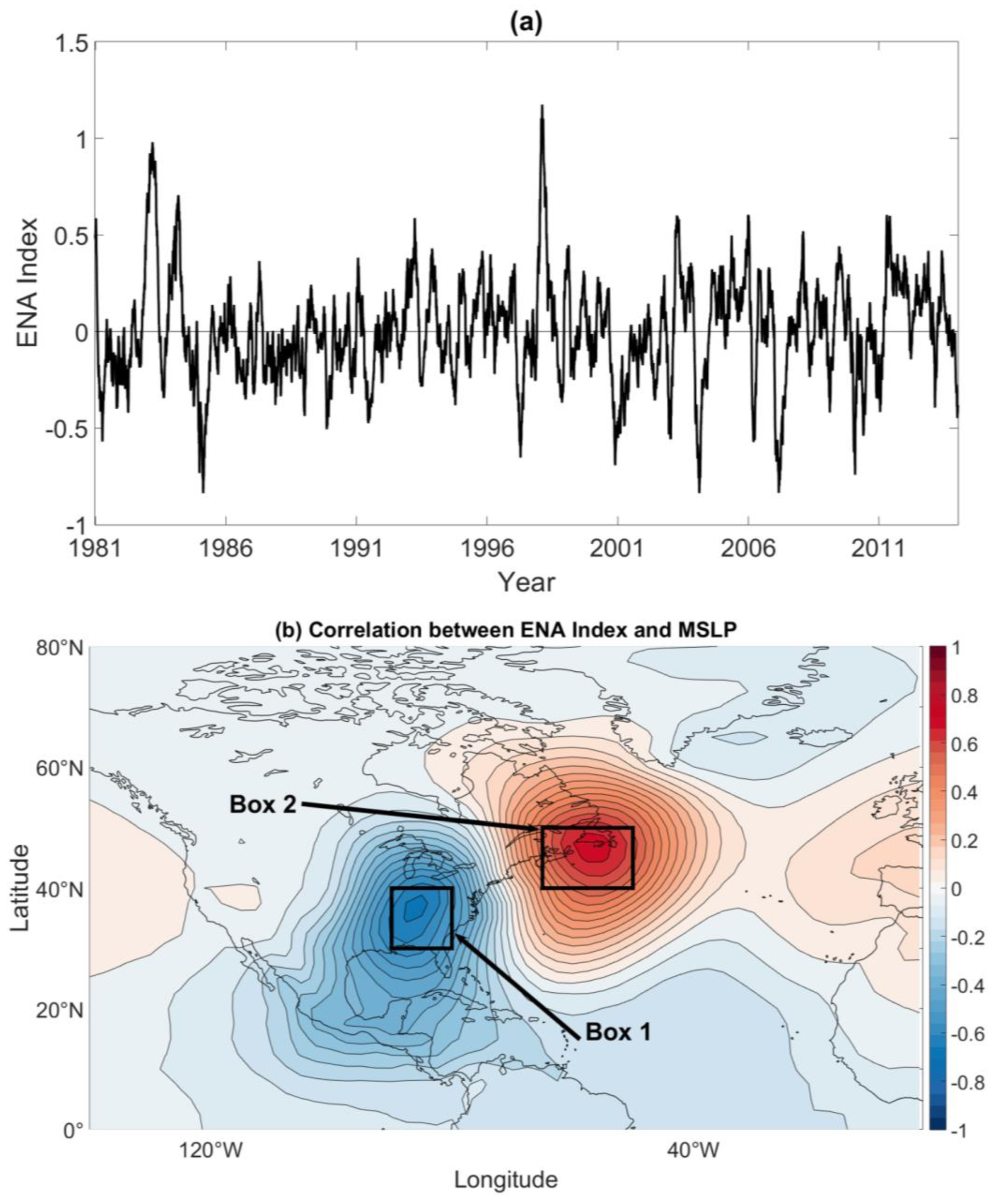
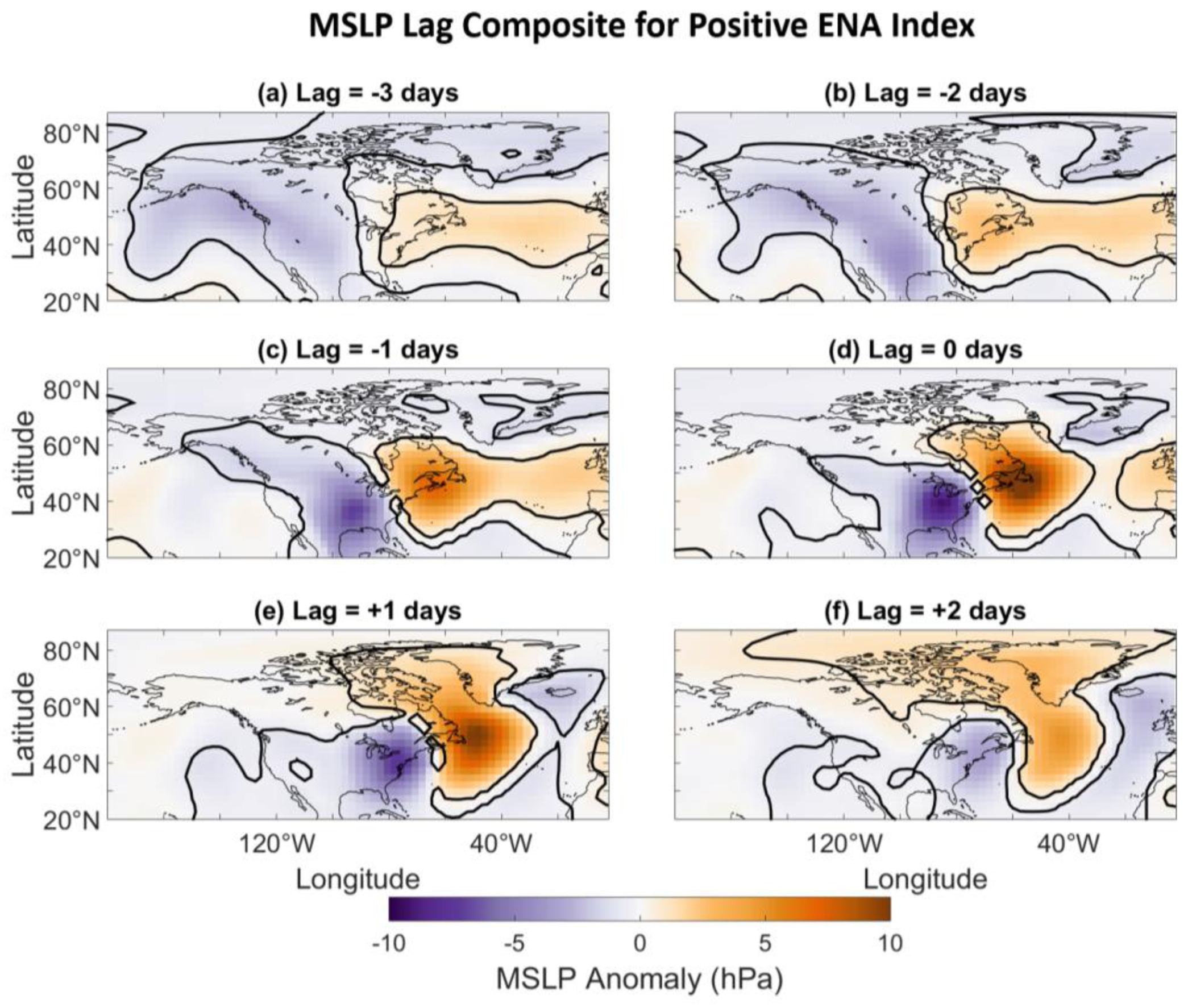
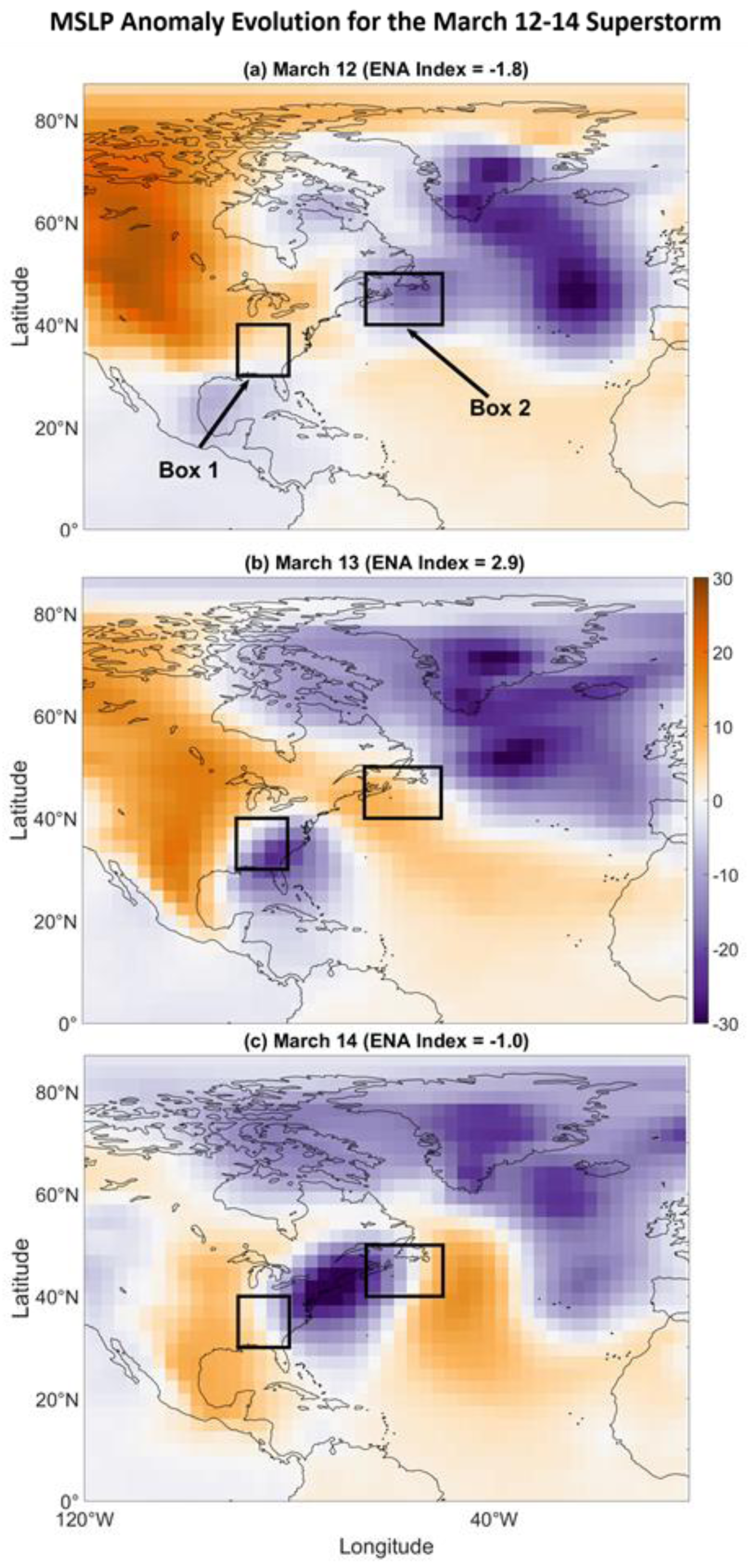
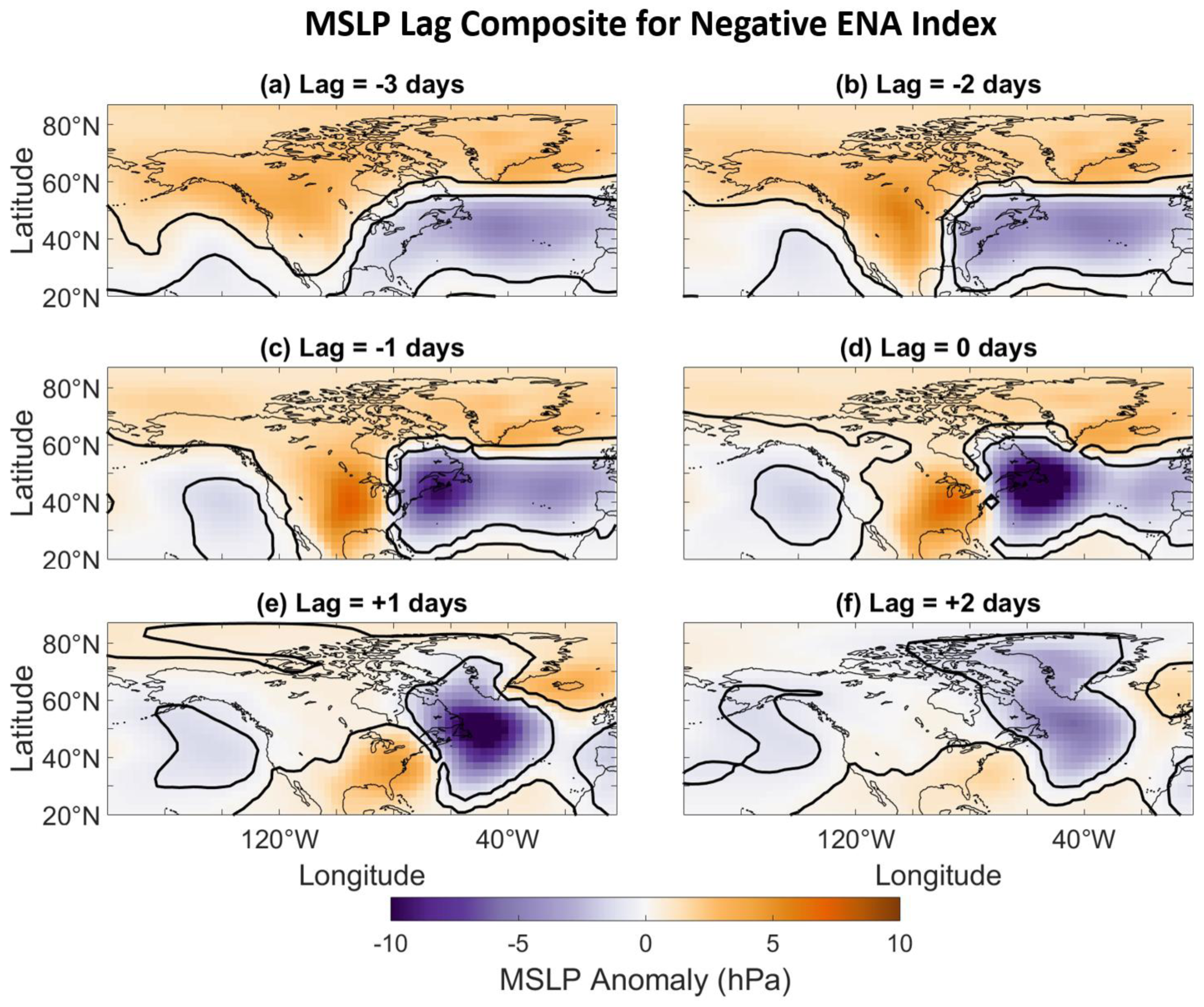

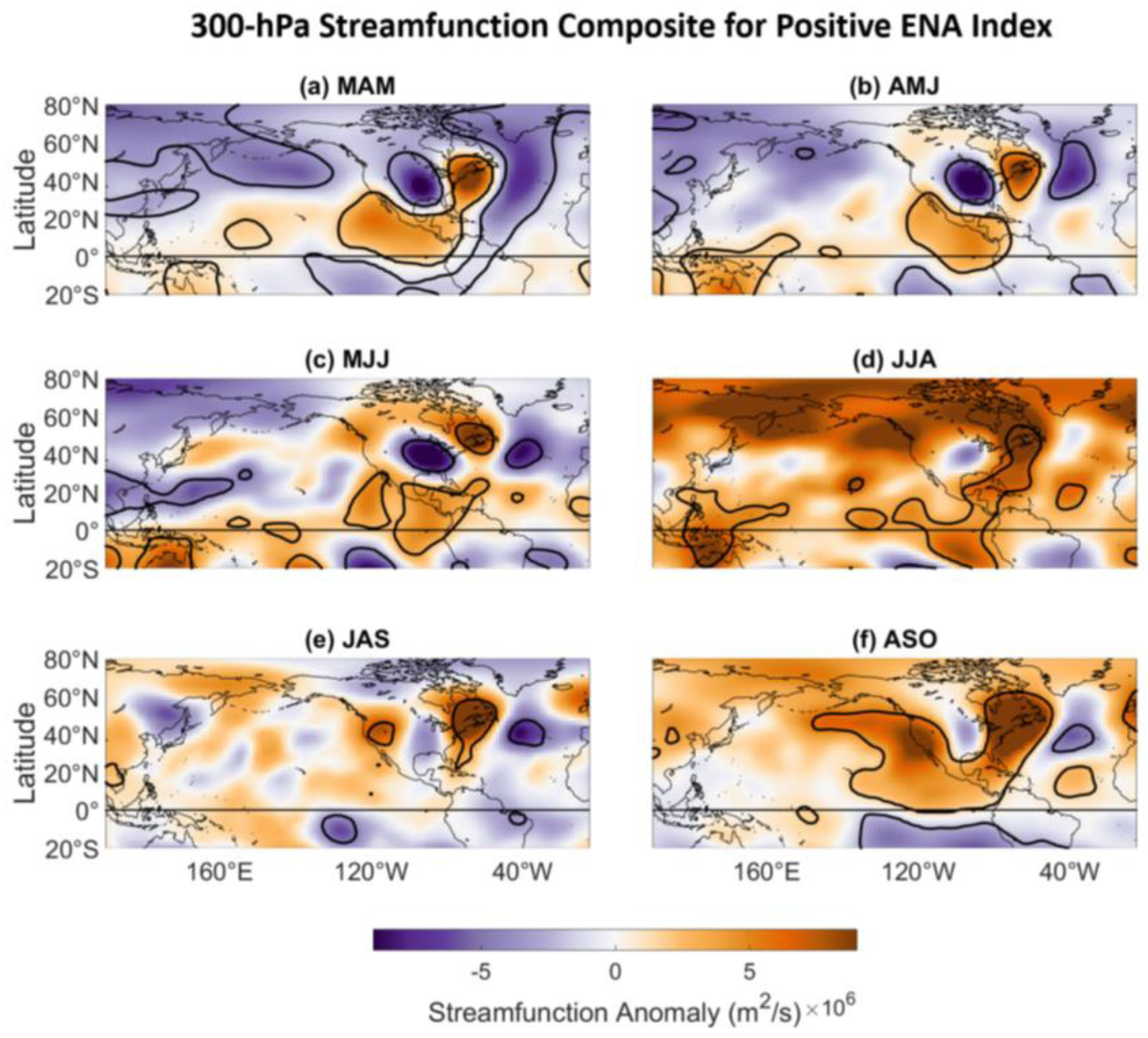
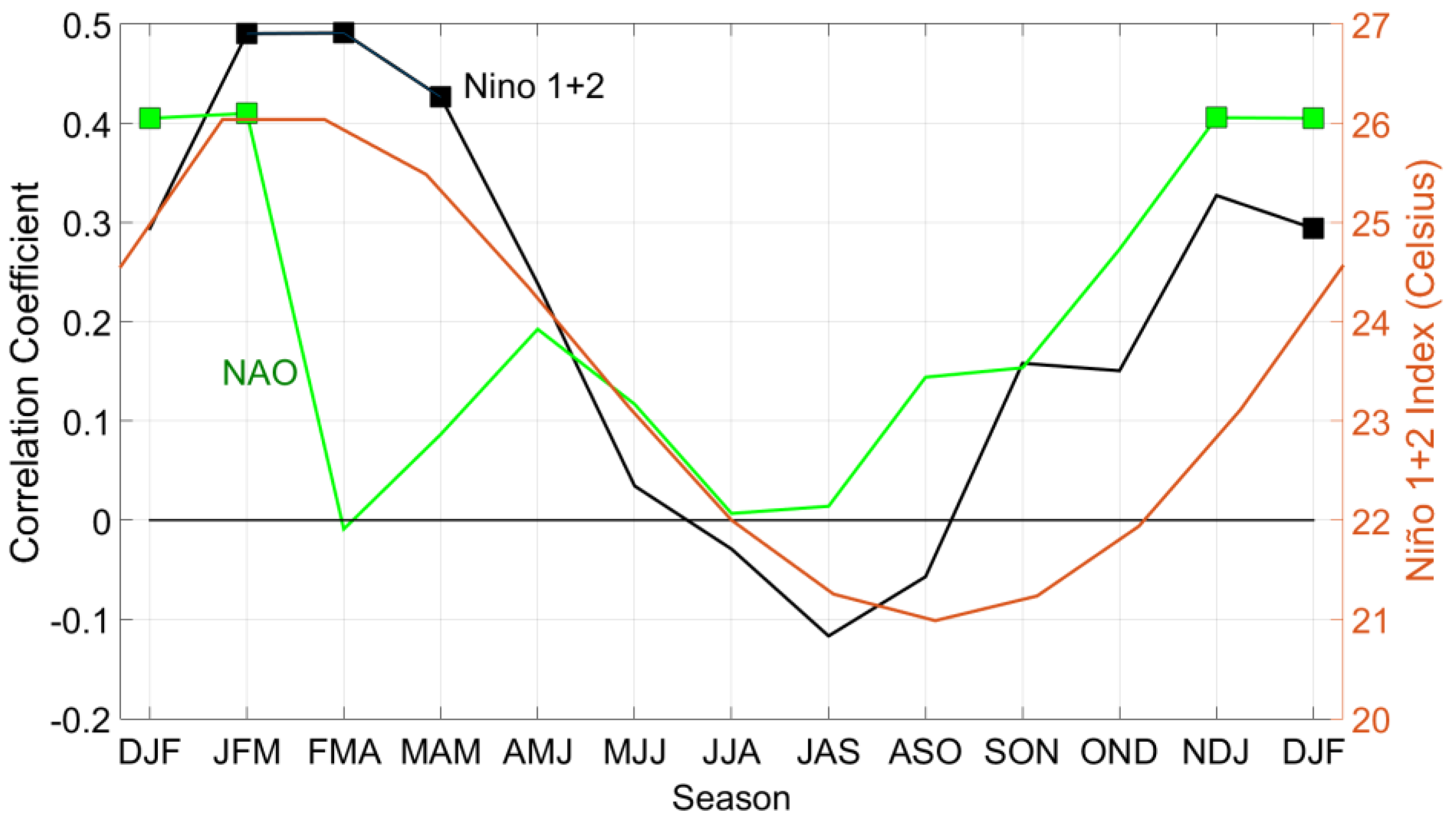
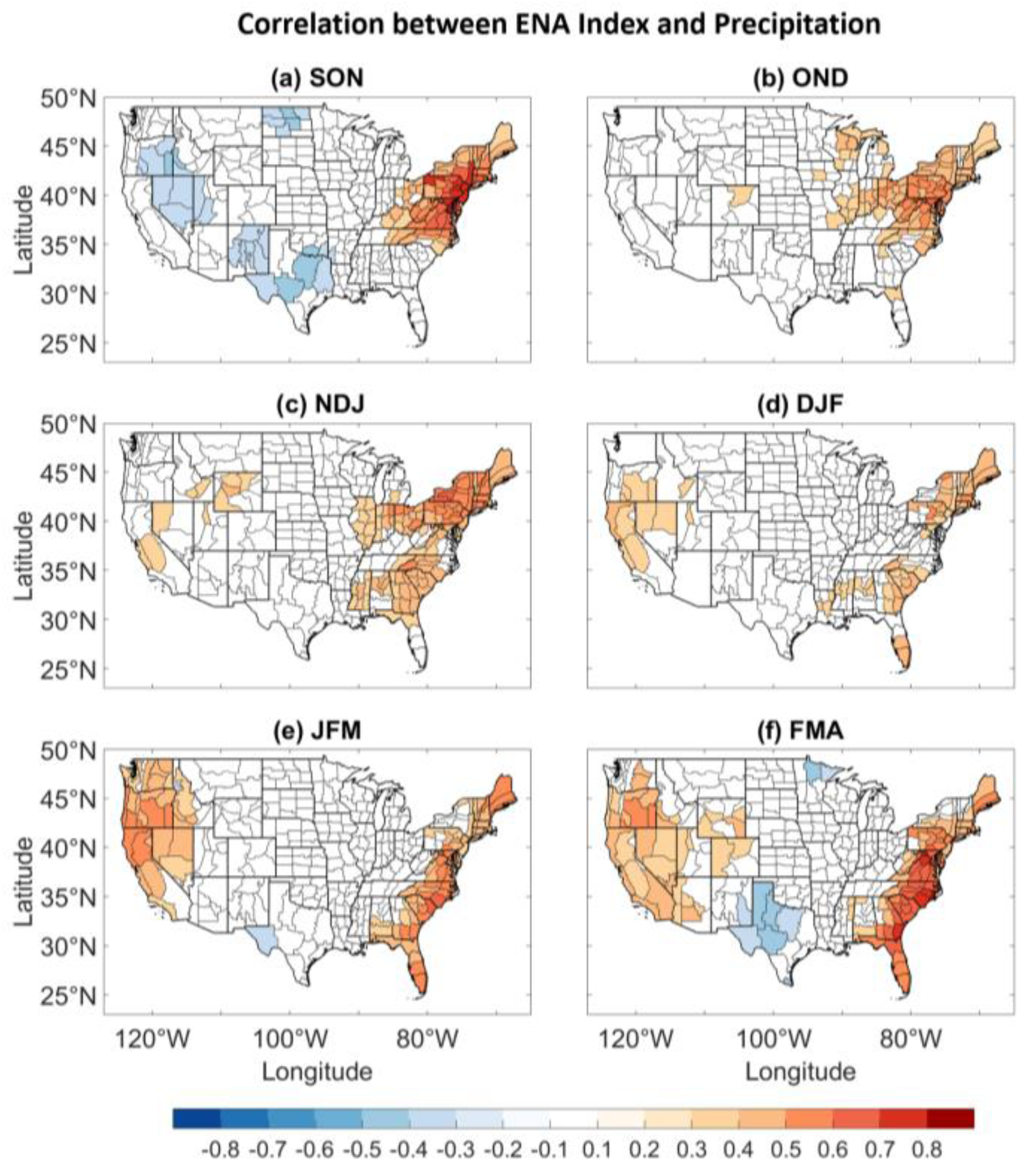
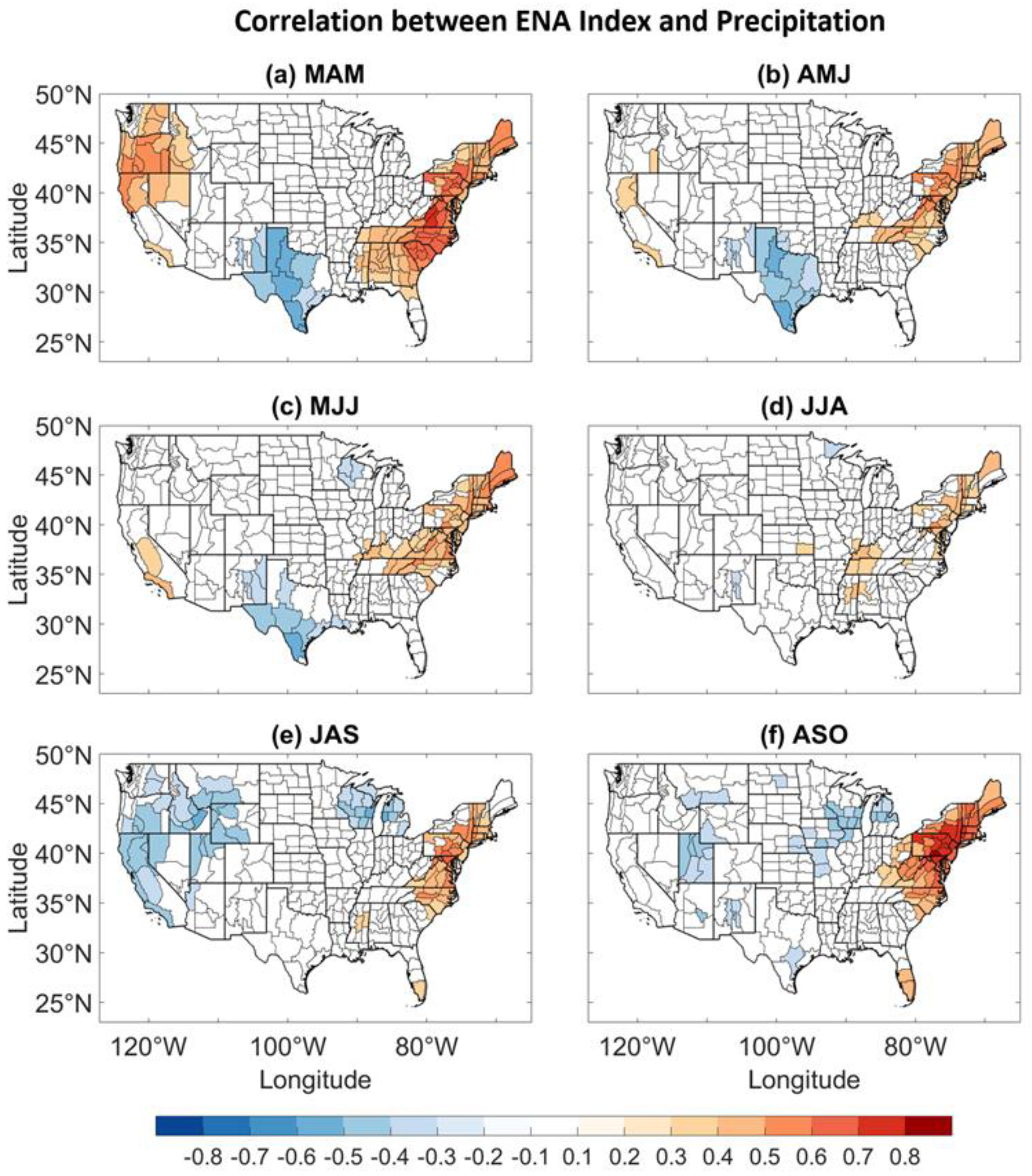


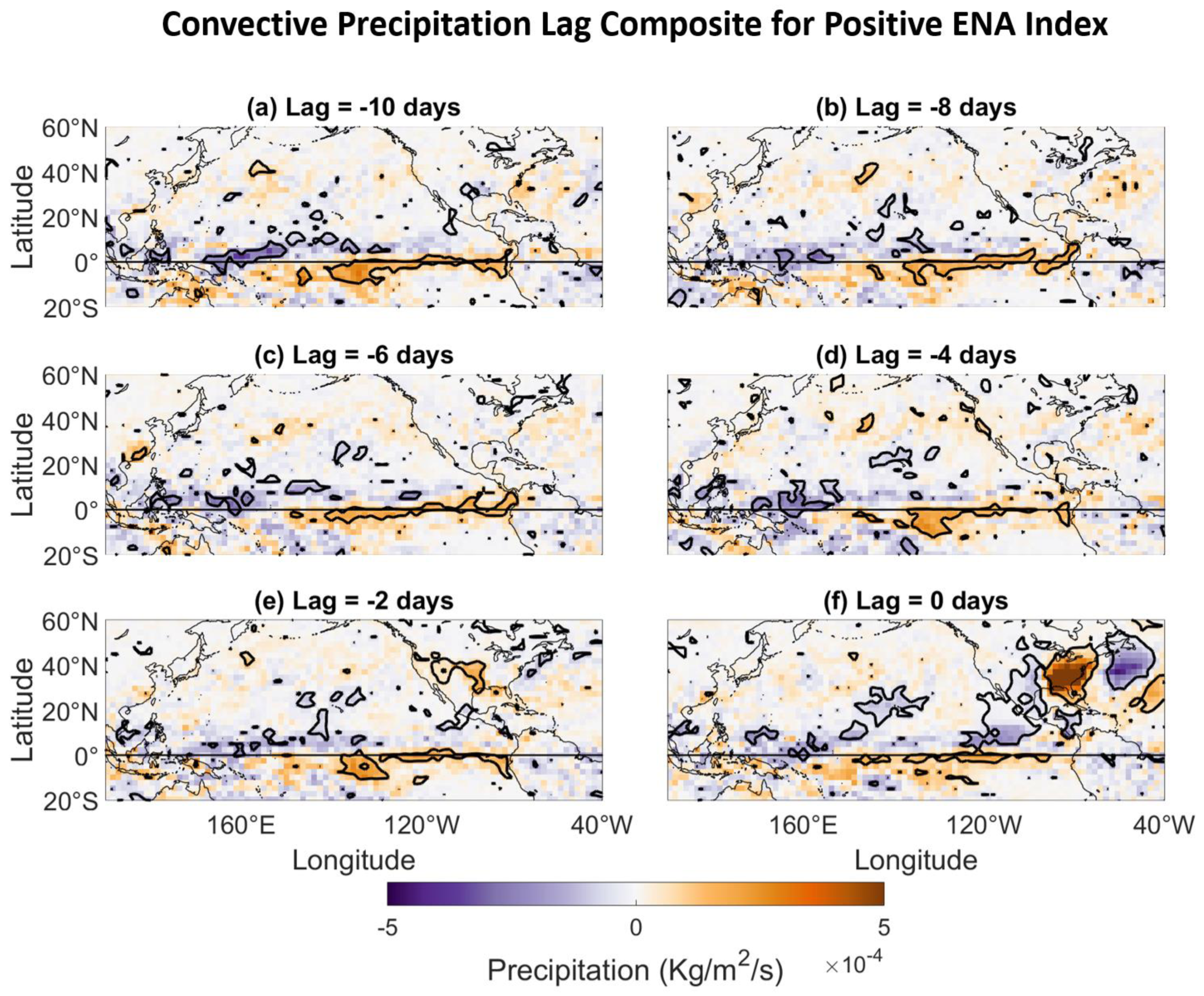
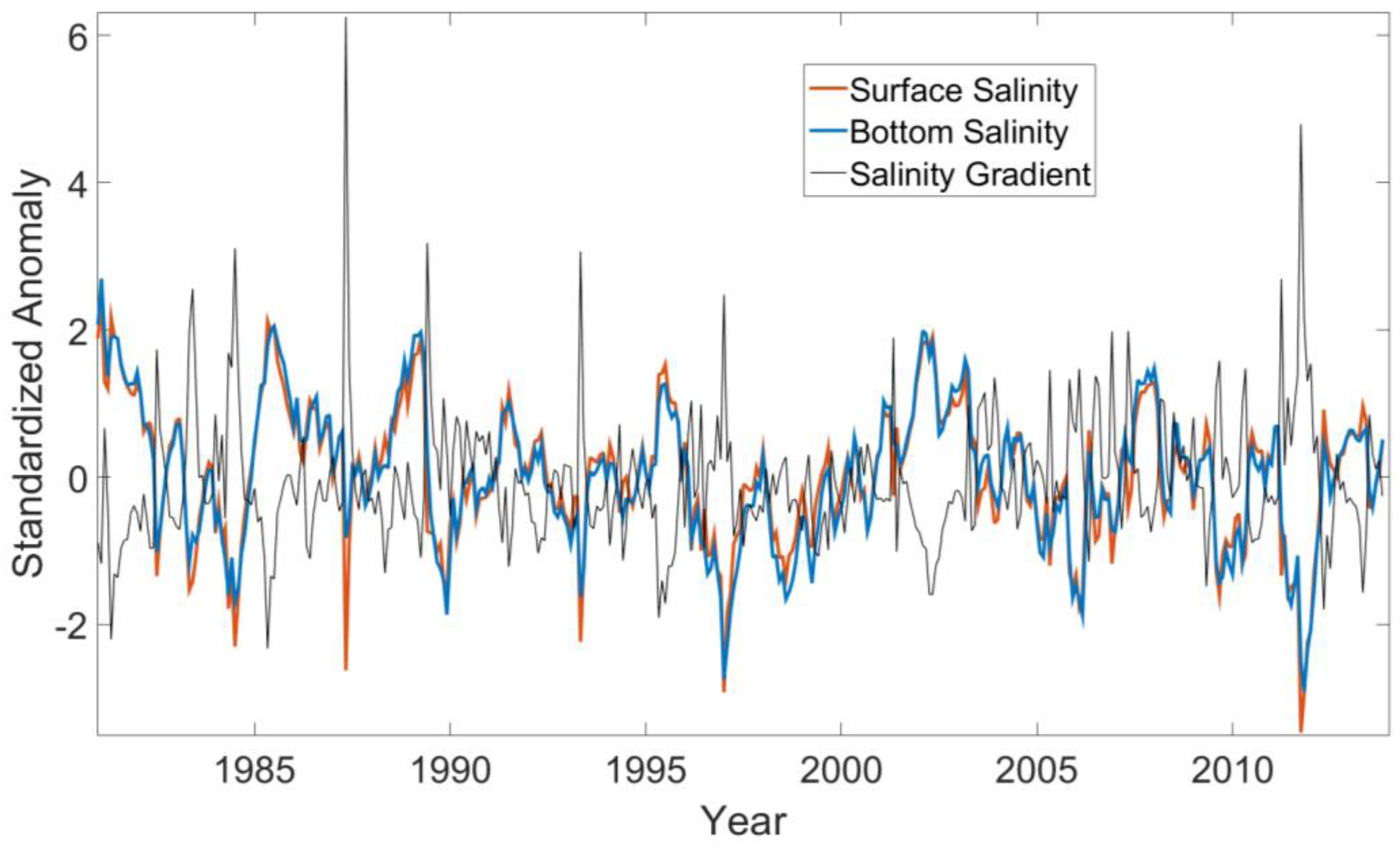

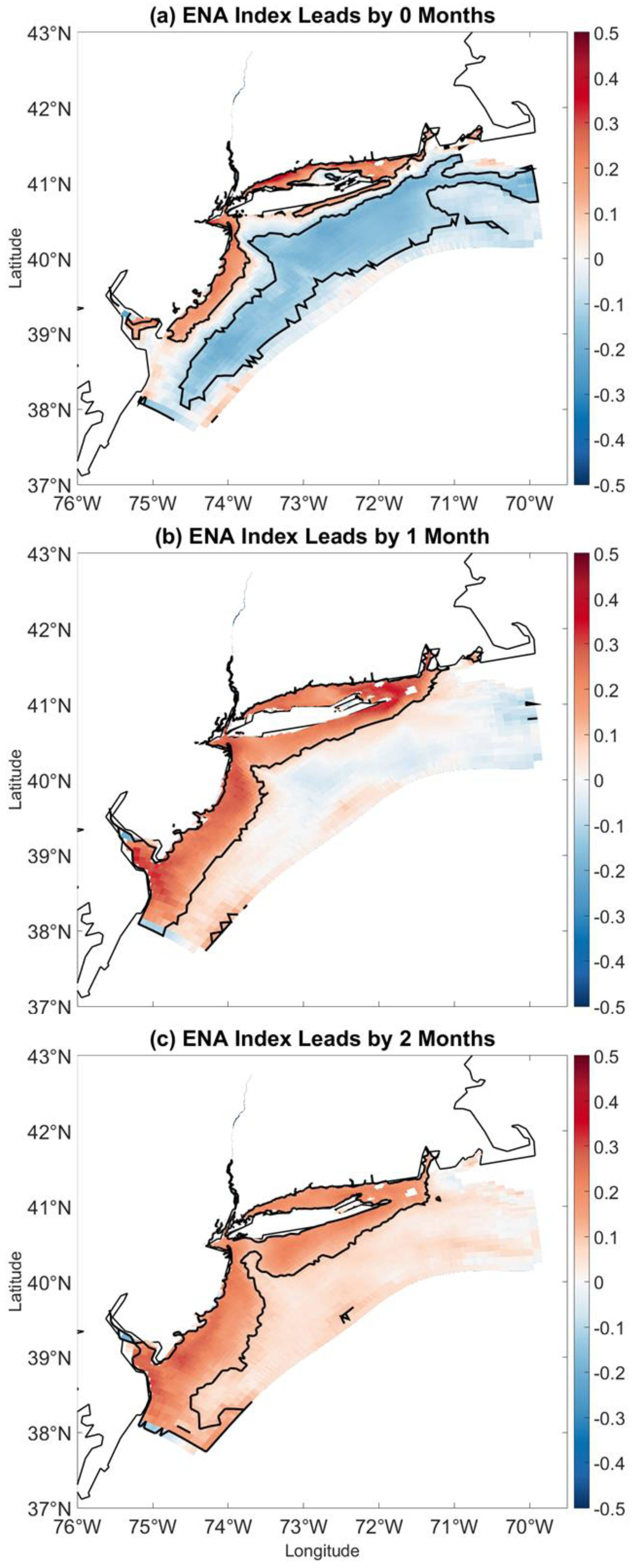
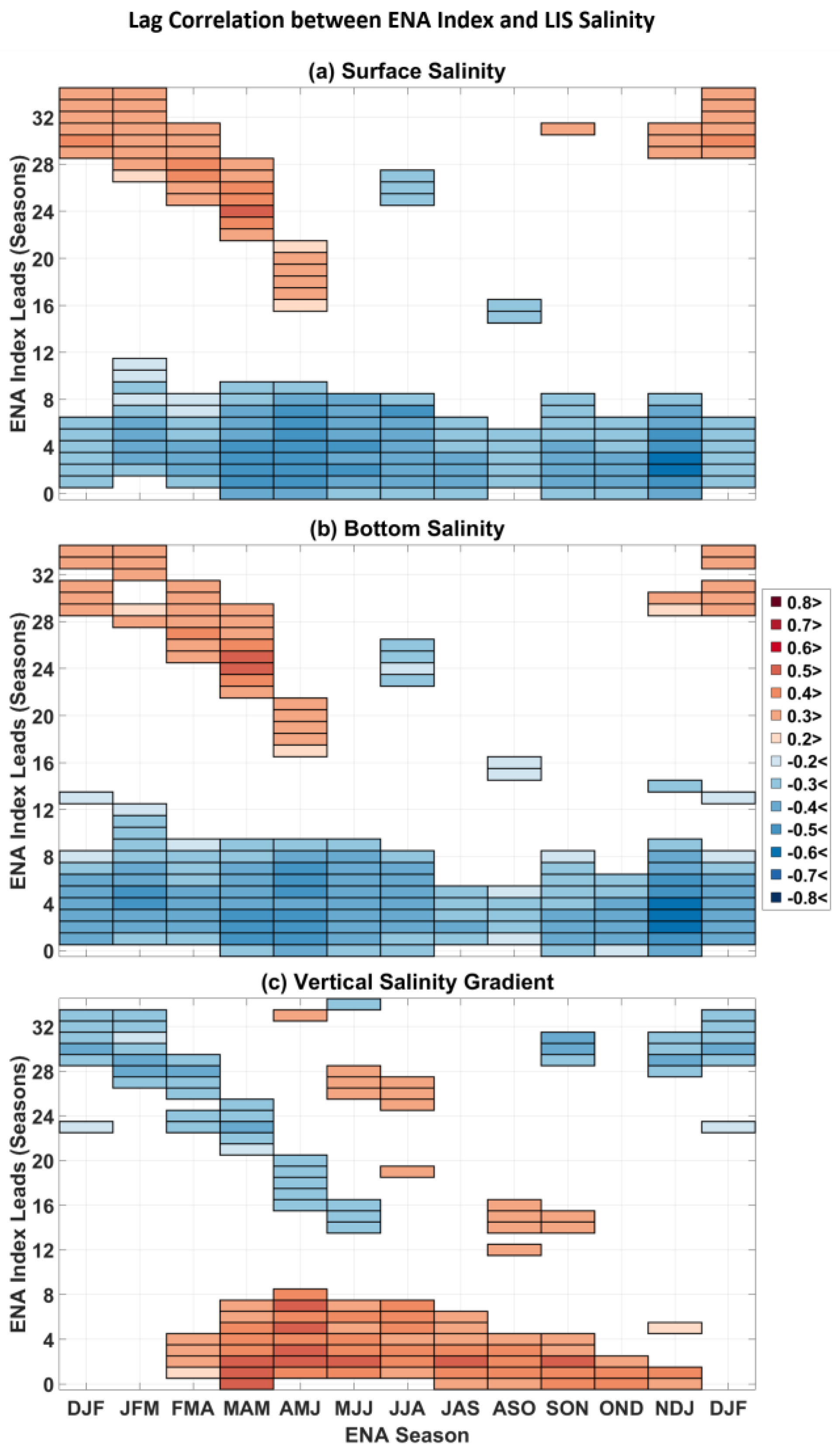
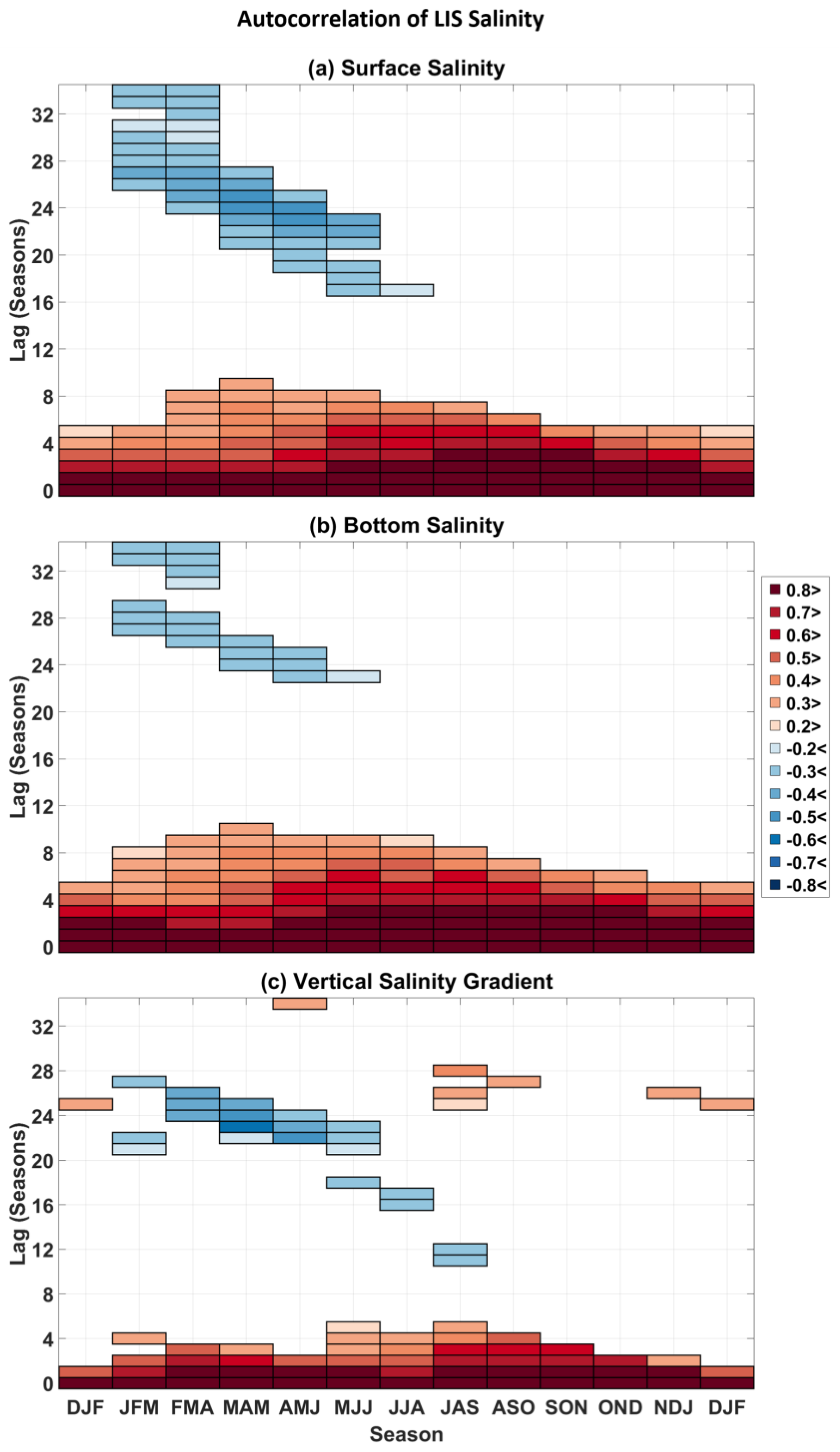
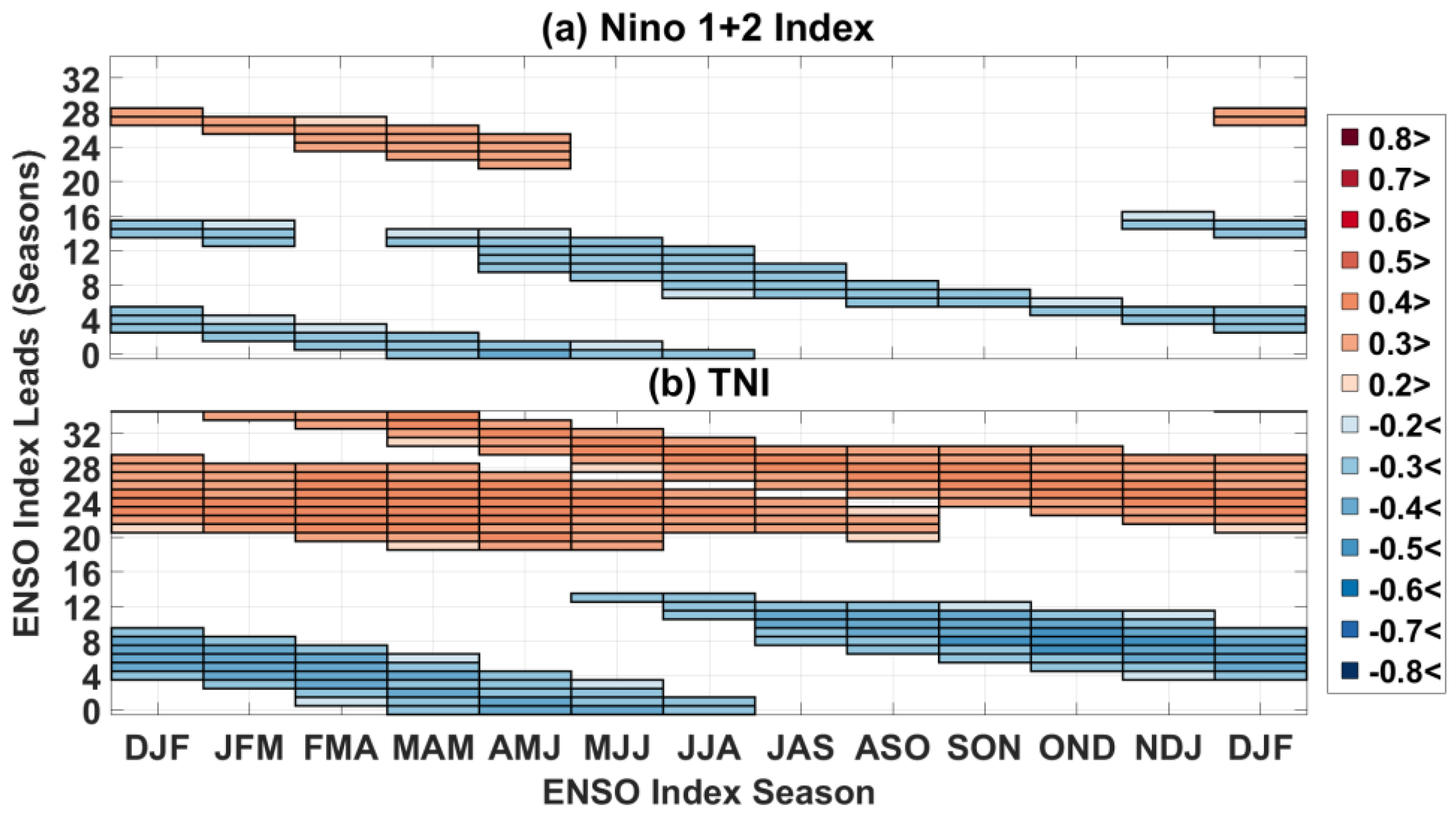
© 2017 by the authors. Licensee MDPI, Basel, Switzerland. This article is an open access article distributed under the terms and conditions of the Creative Commons Attribution (CC BY) license (http://creativecommons.org/licenses/by/4.0/).
Share and Cite
Schulte, J.A.; Georgas, N.; Saba, V.; Howell, P. Meteorological Aspects of the Eastern North American Pattern with Impacts on Long Island Sound Salinity. J. Mar. Sci. Eng. 2017, 5, 26. https://doi.org/10.3390/jmse5030026
Schulte JA, Georgas N, Saba V, Howell P. Meteorological Aspects of the Eastern North American Pattern with Impacts on Long Island Sound Salinity. Journal of Marine Science and Engineering. 2017; 5(3):26. https://doi.org/10.3390/jmse5030026
Chicago/Turabian StyleSchulte, Justin A., Nickitas Georgas, Vincent Saba, and Penelope Howell. 2017. "Meteorological Aspects of the Eastern North American Pattern with Impacts on Long Island Sound Salinity" Journal of Marine Science and Engineering 5, no. 3: 26. https://doi.org/10.3390/jmse5030026




